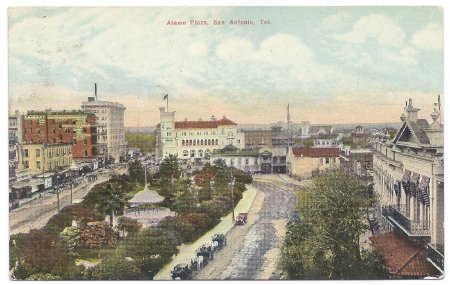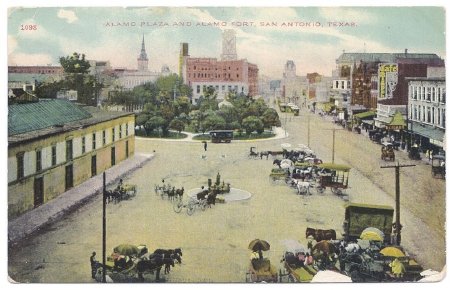History:
Unlike other revered historic battlefields, such as Gettysburg, the Alamo came to be surrounded by a thriving town, where people briskly conducted business, sought entertainment, and met to socialize on the plaza.
"Located in the center of downtown San Antonio, adjacent to Hemisfair [Park] on the south and to the San Antonio River on the west, [lies] the commercial area that grew up around Texas' most famous shrine, the Alamo" (National Register). The Alamo Plaza Historic District contains the church and grounds of the former Mission San Antonio de Valero, a public plaza, and the surrounding commercial structures built mainly in the late 19th and early 20th century (National Register).
Alamo Plaza has long played a pivotal role in the identity and economic well–being of San Antonio. In 1877, San Antonio experienced a boom in population and prosperity brought about by the arrival of the Galveston, Harrisburg & San Antonio Railroad. The following year, the first streetcar line connected the railroad depot on Austin Street to Alamo Plaza (Hemphill, 11), which began to grow in commercial and civic importance.
Throughout the plaza's ongoing evolution, skirmishes have been fought in state courts, at city hall, and in the newspapers, as concerned citizens have sought to balance the claims of the past against the possibilities of the future. While Main Plaza is San Antonio's historic center, Alamo Plaza remains the city's heart.
"Located in the center of downtown San Antonio, adjacent to Hemisfair [Park] on the south and to the San Antonio River on the west, [lies] the commercial area that grew up around Texas' most famous shrine, the Alamo" (National Register). The Alamo Plaza Historic District contains the church and grounds of the former Mission San Antonio de Valero, a public plaza, and the surrounding commercial structures built mainly in the late 19th and early 20th century (National Register).
Alamo Plaza has long played a pivotal role in the identity and economic well–being of San Antonio. In 1877, San Antonio experienced a boom in population and prosperity brought about by the arrival of the Galveston, Harrisburg & San Antonio Railroad. The following year, the first streetcar line connected the railroad depot on Austin Street to Alamo Plaza (Hemphill, 11), which began to grow in commercial and civic importance.
Throughout the plaza's ongoing evolution, skirmishes have been fought in state courts, at city hall, and in the newspapers, as concerned citizens have sought to balance the claims of the past against the possibilities of the future. While Main Plaza is San Antonio's historic center, Alamo Plaza remains the city's heart.
About this Image:
1.) A postcard looking north across Alamo Plaza. Pictured left to right: Crockett Block, Maverick Bank, Gibbs Building, U.S. Courthouse and Post Office, the Alamo, and Menger Hotel. A bandstand occupies the center of the landscaped park.
2.) A postcard looking south across Alamo Plaza. Visible left to right: Hugo–Schmeltzer Building, the steeple of Saint Joseph's Catholic Church, Gallagher Building, Joske's Store, Dullnig Building, Reuter Building, Opera House, Wickes Building, and Crockett Block. Horse–drawn carriages and wagons stand on the plaza, while streetcars travel up Alamo Street.
2.) A postcard looking south across Alamo Plaza. Visible left to right: Hugo–Schmeltzer Building, the steeple of Saint Joseph's Catholic Church, Gallagher Building, Joske's Store, Dullnig Building, Reuter Building, Opera House, Wickes Building, and Crockett Block. Horse–drawn carriages and wagons stand on the plaza, while streetcars travel up Alamo Street.


